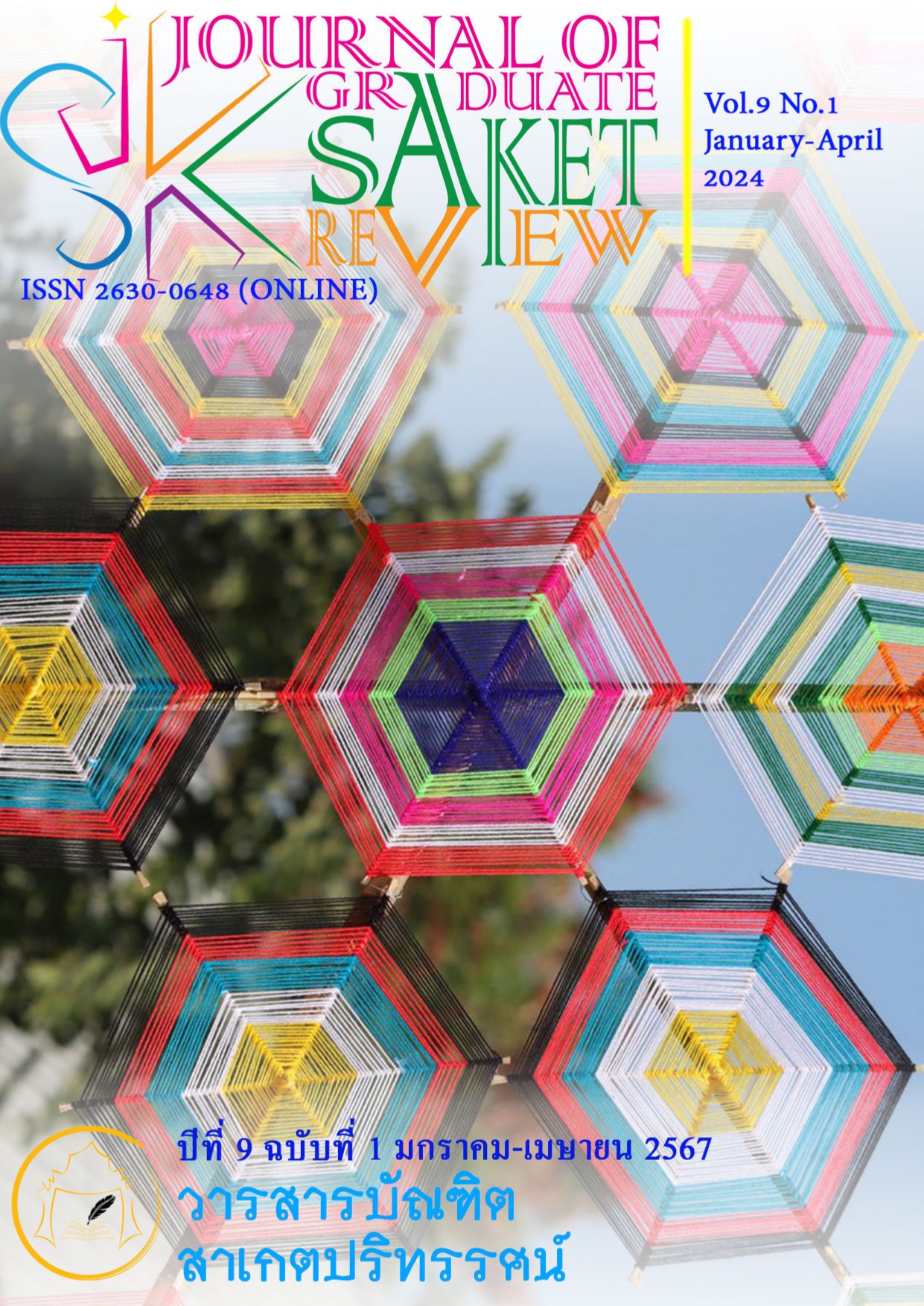An application of modern media innovations to promote the development of quality of life according to Buddhist ethics that appears in Isan folk tales
Main Article Content
Abstract
This research objectives were (1) to study Buddhist morals appearing in Isan folktales. (2) to produce and apply modern media innovation to promote the development of quality of life according to Buddhist morals appearing in Isan folktales. This research is quantitative research. There were 40 key informants for this research. The research tools were observations, in-depth interviews, focus group discussions. The data analyzed using descriptive methods.
The results of the study found that Using the wisdom of the characters in the story of Suwannasangkumar, such as Phra Sang's mother secretly watching people clean the house and destroy the conch shells. In order for the Sangha to no longer have a place to hide, showing respect in the story of the Urangkha relics, such as Phra Maha Kassapa Thera along with 500 Arahants, brought the Urangkha relics of the Lord Buddha to be enshrined at Phu Langka so that all Buddhists and deities can pay homage, forgiveness in the story of Nang Sib Song, such as Thao Rod Sit forgiving Nang Santhamala, governance that appears in the story of Phraya Khan Khak, such as Phraya Khan Khak raising cards. The soldiers went up to fight with Phraya Than to get Phraya Than to let the rain fall according to the season. As for governance according to Buddhist principles in the story of Siaw Sawat, it is The use of wisdom and morality in the work of Thao Siewsawat, activities related to the use of intellectual reflection, i.e. How to activities (problem solving), activities related to respect for others, i.e. activities to promote the cultivation of citizenship consciousness, activities regarding Forgiveness 3 activities, such as teamwork, etc. Activities related to governance according to Buddhist principles, such as selecting MPs, etc.
Article Details

This work is licensed under a Creative Commons Attribution-NonCommercial-NoDerivatives 4.0 International License.
เนื้อหาและข้อมูลในบทความที่ลงตีพิมพ์ในวารสารบัณฑิตสาเกตปริทรรศน์ ถือเป็นข้อคิดเห็นและความรับผิดชอบของผู้เขียนบทความโดยตรงซึ่งกองบรรณาธิการวารสาร ไม่จำเป็นต้องเห็นด้วย หรือร่วมรับผิดชอบใด ๆบทความ ข้อมูล เนื้อหา รูปภาพ ฯลฯ ที่ได้รับการตีพิมพ์ในวารสารบัณฑิตสาเกตปริทรรศน์ ถือเป็นลิขสิทธิ์ของวารสารบัณฑิตสาเกตปริทรรศน์ หากบุคคลหรือหน่วยงานใดต้องการนำทั้งหมดหรือส่วนหนึ่งส่วนใดไปเผยแพร่ต่อหรือเพื่อกระทำการใด ๆ จะต้องได้รับอนุญาตเป็นลายลักอักษรจากวารสารบัณฑิตสาเกตปริทรรศน์ ก่อนเท่านั้น
References
กลุ่มงานพัฒนาหลักสูตรการศึกษาขั้นพื้นฐานและกระบวนการเรียนรู้ สำนักงานเขตพื้นที่การศึกษามัธยมศึกษาขอนแก่น สำนักงานคณะกรรมการการศึกษาขั้นพื้นฐาน กระทรวงศึกษาธิการ. (ม.ป.ป.). คู่มือแนวทางจัดกิจกรรมการเรียนรู้เพื่อส่งเสริมพหุปัญญาของผู้เรียนระดับมัธยมศึกษา. ขอนแก่น: กลุ่มงานพัฒนาหลักสูตรการศึกษาขั้นพื้นฐานและกระบวนการเรียนรู้ สำนักงานเขตพื้นที่การศึกษามัธยมศึกษาขอนแก่น สำนักงานคณะกรรมการการศึกษาขั้นพื้นฐาน กระทรวงศึกษาธิการ.
คมสินธุ์ ต้นสีนนท์. (2561). การจัดการเรียนรู้ตามหลักโยนิโสมนสิการในรายวิชาพระพุทธศาสนา ของนักเรียนชั้นมัธยมศึกษาปีที่ ๒ โรงเรียนหอวัง ปทุมธานี ตำบลสวนพริกไทย อำเภอเมืองปทุมธานี จังหวัดปทุมธานี (สาขาวิชาการสอนสังคมศึกษา). วิทยานิพนธ์พุทธศาสตรมหาบัณฑิต สาขาวิชาการบริหารจัดการคณะสงฆ์ บัณฑิตวิทยาลัย มหาวิทยาลัยมหาจุฬาลงกรณราชวิทยาลัย.
จุรี สายจันเจียม. (2558). พระพุทธศาสนาเป็นรากฐานทางรัฐศาสตร์. วารสารมหาวิทยาลัยมหามกุฏราชวิทยาลัย วิทยาเขตร้อยเอ็ด. 4(1), 398-401.
นางพจนีย์ เพ็งเปลี่ยน. (2532). การศึกษาวรรณกรรมอีสานเรื่องสุวรรณสังข์กุมาร. วิทยานิพนธ์ศิลปะศาสตร มหาบัณฑิต สาขาวิชาจารึกภาษาไทย ภาควิชาตะวันออก บัณฑิตวิทยาลัย มหาวิทยาลัยศิลปากร.
พระธีทัต กิตฺติวณฺโณ. (2560). ศึกษาการเสริมสร้างพฤติกรรมการแสดงการเคารพของเยาวชนบ้านศิริพร ตำบลไคสี อำเภอเมืองบึงกาฬ จังหวัดบึงกาฬ. วารสารธาตุพนมปริทรรศน์. 1(2), 1-12.
พระมหาหรรษา ธมฺมหาโส, ผศ.ดร.. (2553). อภัยทานกับการสร้างความสมานฉันท์ในสังคมไทย. สืบค้นเมื่อ 16 กันยายน 2566, จาก https://www.mcu.ac.th/article/detail/453.
พิเชฐ ทั่งโต และคณะ. (2553). การศึกษาวิเคราะหรัฐศาสตรเชิงพุทธในมุมมองของนักวิชาการดานรัฐศาสตรในประเทศไทย. รายงานการวิจัย. มหาวิทยาลัยมหาจุฬาลงกรณราชวิทยาลัย.
บันเทิง พาพิจิตร. (2557). การเปลี่ยนแปลงทางสังคมและวัฒนธรรม. กรุงเทพมหานคร: โอเดียนสโตร์.
พุทธินันทน์ บุญเรือง. (2560). การเปลี่ยนแปลงทางสังคม วัฒนธรรม เศรษฐกิจของชุมชนชายแดนต่อการเข้าสู่ประชาคมเศรษฐกิจอาเซียน (AEC) : การเกิดขึ้นของจุดผ่านแดนถาวรช่องภูดู่และการตอบสนองของคนท้องถิ่นในอำเภอบ้านโคก จังหวัดอุตรดิตถ์. วารสารวิชาการแพรวากาฬสินธุ์ มหาวิทยาลัยกาฬสินธุ์. 4(1), 1-21.
มนตรี โคตรคันทา. (2565). นิทานท้าวเสียวสวาสดิ์. สืบค้นเมื่อ 16 กันยายน 2566, จาก https:// www.isangate.com/new/9-word/849-siew-sawad.html.
วิภาพรรณ พินลา. (2559). แนวทางการจัดกิจกรรมการเรียนรู้สังคมศึกษา เพื่อพัฒนาความเป็นพลเมืองดีตามวิถีประชาธิปไตยสำหรับผู้เรียนยุคศตวรรษที่ 21. วารสารการศึกษาและการพัฒนาสังคม. 12(1), 20-34.
สมศักดิ์ ศรีสันติสุข. (2558). โสวัฒนธรรมอีสาน. เชียงใหม่: ภาควิชาสังคมวิทยาและมานุษยวิทยา คณะสังคมศาสตร์ มหาวิทยาลัยเชียงใหม่.
โสรัจ นามอ่อน และคณะ. (2551). การวิเคราะห์อิทธิพลนิทานพื้นบ้านจากหนังสือใบลานอักษรธรรมอีสาน ในจังหวัดอุบลราชธานี. รายงานการวิจัย. มหาวิทยาลัยมหาจุฬาลงกรณราชวิทยาลัย.
สำนักวัฒนธรรม มหาวิทยาลัยขอนแก่น. (ม.ป.ป.). พระไตรรัตน์ในอีสาน วรรณกรรมพระพุทธศาสนา 50 เรื่อง. สืบค้นเมื่อ 16 กันยายน 2566, จาก https://cackku.wixsite.com/phratrairat2/copy-of-35.
สุจิตต์ วงษ์เทศ. (2559). พญาคันคาก นิทานชาวบ้านลาว-ไทย เรื่องคางคกยกรบขอฝน. สืบค้นเมื่อ 16 กันยายน 2566, https://www.matichonweekly.com/scoop/article_9785.
อธิราชย์ นันขันตี. (2563). นิทานอุรังคธาตุ. อุบลราชธานี: หอสมุดแห่งชาติเฉลิมพระเกียรติ สมเด็จพระนางเจ้าสิรกิตติ์ พระบรมราชินีนาถ นครพนม สำนักศิลปากรที่ 9 อุบลราชธานี กรมศิลปากร กระทรวงวัฒนธรรม.
Enright, R. D. (2008). Forgiveness is a Choice. Washington, DC.: APA Life Tools.


